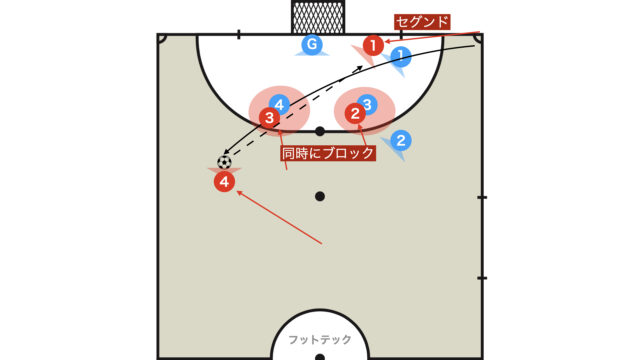Set-pieces occur primarily in the following situations.
- When the ball goes out of the court (when it crosses the touchline)
- When a foul occurs (foul, back-pass, etc.)
- When the ball hits the ceiling
- When the ball bursts
This article explains the rules and a brief overview of each set-piece.
Rules
4-Second Rule
The referee starts counting from the moment the kicker is ready, and the restart must occur within 4 seconds.
(The speed of the 4-second count varies by referee)
If more than 4 seconds pass, the set-piece is awarded to the opposing team.
5m Rule
Basically, in most set-pieces, players must be at least 5 meters away from the ball, so when setting up a defensive wall, you must be aware of the 5-meter distance.
If the wall is set up too close, thereby obstructing the opposing team’s restart, a yellow card will be issued.
Goal Clearance (GC)
Once the opponent’s last touch has completely crossed your goal line, it is considered a goal clearance.
Goal clearance is a set-piece in which the Goleiro throws the ball from within the penalty area to restart play. Since a back-pass is not allowed, it is more advisable to pass the ball into the space behind or to the pivo rather than to a teammate in your own half.
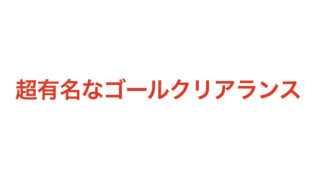
Kick-In (KI)
If the ball completely crosses the touchline, the kick-in is awarded to the team opposite to the last team that touched the ball.
If the ball hits the ceiling, the kick-in is taken from the point on the touchline closest to where the ball struck the ceiling by the team opposite to the last team that touched the ball.
- The ball must come to a complete stop on the line where it went out
- A direct goal is not allowed, and it will be treated as a goal clearance (direct own goals are also not allowed and result in a corner kick for the opposition)
- Only one foot (the stepping foot) may be outside the pitch (according to the 2020/2021 rule revision)
Own Side Kick-In
Since the own side kick-in is far from the goal, many teams use sign play to avoid it.
Utilizing the allowance of one back-pass to involve the Goleiro in the attack has become globally popular as an avoidance tactic.
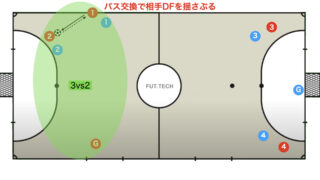
Opponent’s Kick-In
An opponent’s kick-in is a set-piece close to the goal, which allows for scoring with relatively little effort.
Among these, the “chon-don”, in which the kicker chon passes and the shooter don strikes, is very famous—a simple yet powerful set-piece that is hard to stop even when anticipated.
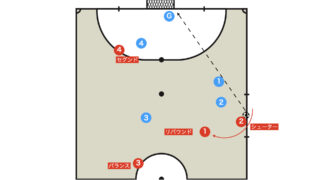
Corner Kick (CK)
Once the opposing team’s last touch has completely crossed their own goal line, a corner kick is awarded from the nearest corner to that point.
- The ball must be placed within the corner area (arc)
- A direct goal is allowed (direct own goals are not allowed and result in a corner kick for the opposition)
- The 4-second rule applies
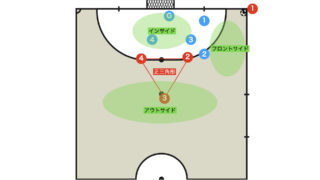
Kick-Off
After one team scores, the opposing team performs the kick-off.
- The ball must be stationary on the center mark and, once kicked, must clearly be in play.
- Opponents must be at least 3 meters away from the ball until it is in play (they must not enter the center circle).
- A direct goal is allowed (direct own goals are not allowed and result in a corner kick for the opposition).
- Only the kicker (the person who kicks the ball first) is allowed to enter the opponent’s half; all other players must remain in their own court.
Due to the 2020/2021 rule changes, it is now permitted to kick the ball backwards.
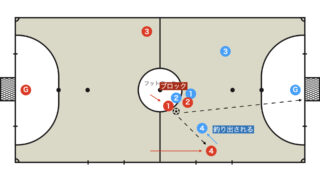
FK
The 4-second rule applies.
The main referee and the second referee signal an indirect free kick by raising one arm above their head, and they continue this signal until the kick is taken and the ball touches another player or goes out of play.
If either the main or second referee fails to signal that the free kick is indirect by raising their arm, yet the ball goes directly into the goal, the indirect free kick must be retaken.
Direct FK
A direct free kick is awarded for committing the following fouls:
- Handball
- Charge, tackle, tripping, etc.
- Biting or spitting at someone
- Violence, throwing objects
If excessive force is used that endangers an opponent, it results in a red card and expulsion.
Indirect FK
If the ball goes directly into the goal without touching an opposing player, it results in a goal clearance for the opposing team (direct own goals are not allowed and result in a corner kick for the opposition).
A foul involving a back-pass results in an indirect free kick.
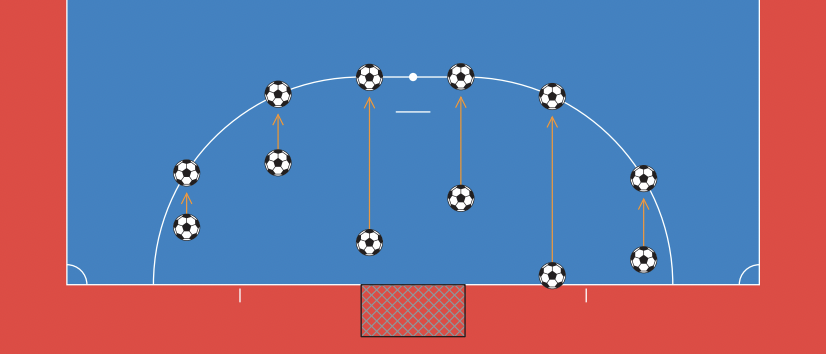
PK
The kicker must be clearly identified.
The defending goalkeeper must remain facing the kicker, on the goal line between the two goal posts until the ball is kicked, and must not touch the goal posts, crossbar, or goal net.
All players other than the kicker and the goalkeeper must be positioned as follows:
- Within the pitch
- At least 5 meters away from the penalty mark
- Behind the penalty mark
Second PK
A count of fouls is accumulated, and when 6 counts are reached, a second penalty kick is awarded to the opposing team.
The foul count is reset at halftime.
PK
If a foul is committed within the penalty area, it results in a penalty kick for the opposing team.
In cup (tournament) matches where the outcome is not decided within regulation time (including extra time), each team takes 5 penalty kicks to determine the winner.
If the goal count remains tied after each team has taken 5 kicks, sudden death ensues.
In the 2020/2021 rule revisions, the number of penalty kicks was changed from 3 to 5.
Summary
In futsal, set-pieces are an important phase where goals are often scored, second only to transitions.
It is recommended to first understand the rules before delving into detailed tactics.
Thank you very much for reading this article to the end.
If you found this article useful, please consider sharing it using the social media share buttons above.
We regularly share valuable insights on futsal tactics on Twitter, so if you haven’t followed us yet, we’d appreciate your support!
We are committed to raising the level of futsal in Japan by sharing high-quality information through discussions with individuals who have coaching experience in the F.League and overseas.
If you have any questions or notice any mistakes, feel free to leave a comment below.
We update our articles regularly, so if you’d like to keep reading, please bookmark our site or search for “FutTech”!
